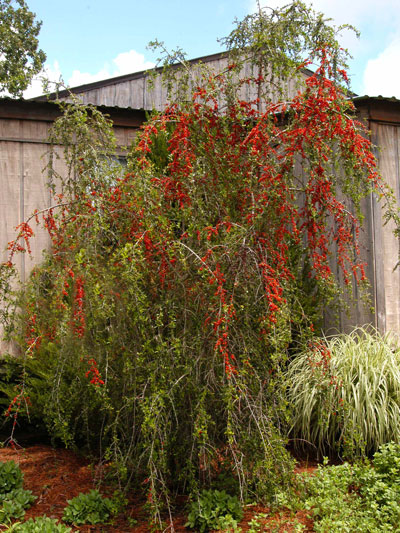A Different Style of Drama
There are times when you want an upright plant to frame the corner of your landscape – something you can set out 12 or 15 feet from the intersection of the front and side of the house to provide a boundary of the two parts of your gardens.
Tree-form crape myrtles can do that. Tree-form yaupon hollies can do that. The much less common tree-form Nellie R. Stevens hollies can do that. Mexican plums, Warren’s Red possumhaw hollies and some of the newer and smaller selections of redbuds all can do it. Oakland and Mary Nell hollies would be great as large shrubs. And, in shady spots, Japanese maples are great little framing trees.

But you’ve thought through all of those and you say you want something even less common? Well, have you considered weeping yaupon holly? This is a great plant worthy of consideration in many more places than you currently see it being used.
In his great reference Hollies (Timber Press, Portland, Oregon, 1997), Fred Galle told us that this handsome variant was found near Folsom, Louisiana, in 1952. It was collected by J.A. Foret and introduced by Tom Dodd, Jr. It is sold as both Folsom’s weeping yaupon and Gray’s weeping yaupon.

What you need to know before you plant it…
• Weeping yaupon holly (Ilex vomitoria pendula)
• Evergreen foliage on distinctly weeping branches
• Adapted to full sun to mostly shade, but denser growth in sun.
• Grows to 16-20 ft. tall and 15-18 ft. wide.
• Both female (fruit-producing) and male (pollen-producing, but fruitless) selections are available, but most sold in nurseries are female.
• Pollinated from bees that carry pollen from male yaupons to the female plants.
• Propagated from cuttings to ensure you will get a genetically identical plant.

• Berries are BB-sized and are borne in copious quantities along the stems, turning red with first cold spells of fall and holding through the winter until harvested by migrating birds in the spring.
• A majority of seedlings from weeping yaupons will have the pendulous habit, but don’t worry – it’s not a plant that reseeds itself freely all over your landscape.
Note: Weeping yaupons tend to have a visually “heavy” look in the landscape due to their multitudes of dense branching. The plants may need occasional pruning and training if they start to lean to one side or the other.
